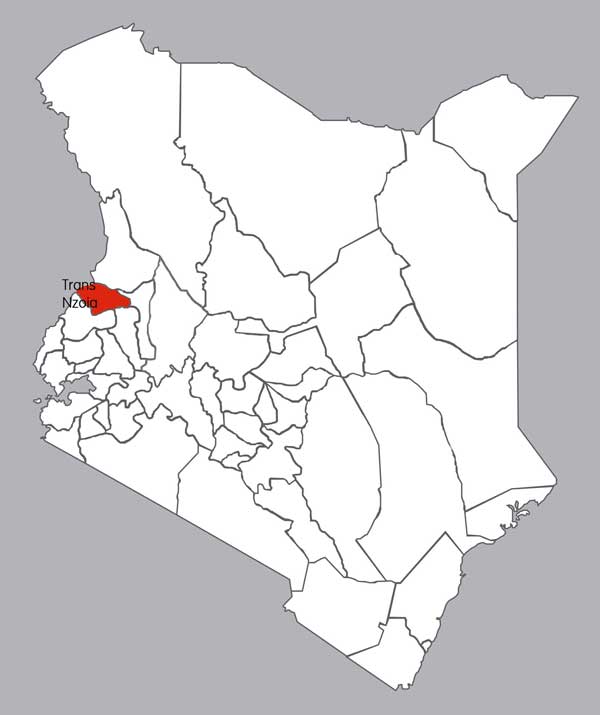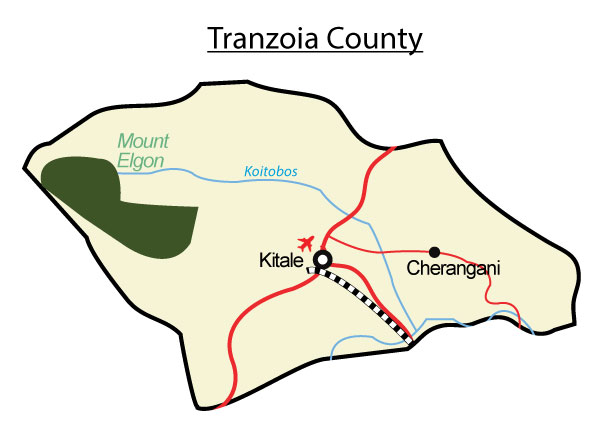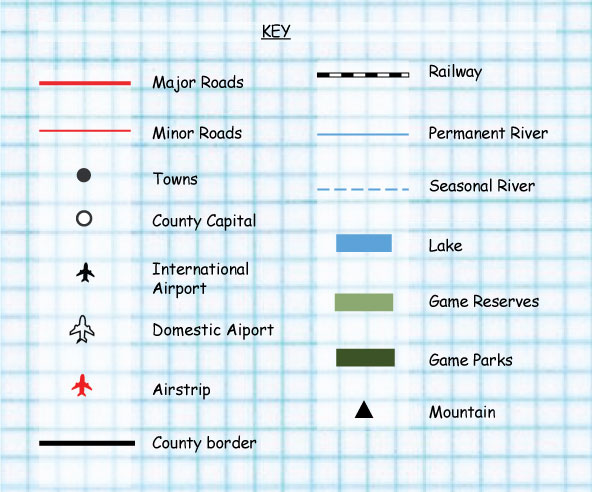Tranzoia County
Introduction
Trans-Nzoia County is a county in the former Rift Valley Province, Kenya, located between the Nzoia River and Mount Elgon 380 km Northwest of Nairobi.
Its center is the town of Kitale which is the capital and largest town.
The county borders Bungoma to the west, Uasin Gishu and Kakamega to the south, Elgeyo Marakwet to the east, West Pokot to the north and the republic of Uganda to the Northwest.
Trans Nzoia covers an area of 2, 495.5 square kilometres.

Constituencies
The county has five constituencies:
- Cherang'any Constituency
- Kwanza Constituency
- Saboti Constituency
- Endebess Constituency
- Kiminini Constituency
The main physical features
Rivers
Mountains
Hills
Valleys
Importance of the physical features
- River Nzoia, provide water for irrigation all year round, while the annual floods around the lowland area of Budalang'i deposit sediment that contributes to the area's good agricultural production.
- Around the industrial region centered at Webuye, the river absorbs a lot of effluent from the paper and sugar factories in the area. The river has a number of spectacular waterfalls, and is thought to possess a good hydroelectricity generation potential.
- Mount Elgon is an important water catchment for the Nzoia River.
- Mount Elgon National Park is home to a variety of wild animals, which attract tourists to the area.
Main types of natural vegetation
- Montain forest to high open moorland studded with the giant lobelia and groundsel plants.
Importance of the vegetation
- The forest zone receives the maximum rainfall and is important in the mountains role as a water catchment for several million people.
Map of distribution of the physical features.


People and population
Language groups
- Bukusu subtribe of the Luhya community
- Kalenjins
Areas of high population density
- Kitale
- Kimilili
- Mali Saba
Areas of low population density
Social relations and cultural activities
Traditional way of life of the people
Food
- Ovukima - maize flour added to boiling water and cooked into a thick paste similar to American grits. Ovukima is eaten with various vegetables such as kale and collard greens, and for those who can afford it, beef or chicken. Chicken is a delicacy and is prepared for important guests or for special occasions.
- Porridge made of maize (corn), millet, or finger millet flour is consumed.
Dressing
- Luhya men used to wear the prepared skin of a goat or a calf.
- Young girls only wore strings of beads round their waists and necks and pierced their ear lobes to put in little decorations.
- The women used to wear liboya, made of banana fibers or sisal or, for richer women (abakhaye), of animals’ tail hairs. The liboya was worn round the waist and looked like a kind of apron hanging in front and a tuft of sisal or hair strings hanging behind.
Songs and dances
- Luhya mulongo song for male circumcision
- Chiswa harvesting songs
- isukuti dance
Traditional medical practices
Ceremonies
The bukusu people name their new born babies according to sikuka (inherited names), cultural practices, and character (kumwima).
The ‘sikuka’ names are names of ancestors who were respected in society. A parent does not choose the name for a child but the child will automatically cry meaning a particular ancestral spirit is disturbing the baby wanting the baby to be named after him/her.
When the child cries during the day, it means the ancestor who wants to be named comes from the mother’s side. When the baby cries non-stop at night, it means the ancestor who wants to be named comes from father’s side.
They practice male circumcision.
Festivals
Harvest
- Chiswa harvesting songs
- isukuti dance
Music
- Luhya mulongo song for male circumcision
- Chiswa harvesting songs
- isukuti dance
Drama
Resources and economic acativities
Agriculture
Main cash crops and food crops grown
Areas where the cash crops are grown
- Kitale -Maize
- Kimilili - Maize
- Bungoma – Maize
- Mt Elgon slopes - Tea
Fishing
Areas where fishing is practiced
- They are no lakes in this county. However, fishing farming is practiced in ponds by farmers in Kitale
Forestry
The major forests
The gazetted forests in the county are;
- Mount Elgon Forest,
- Kitale Town Forest
- Kapolet Forest
- Sikhendu Forest
Wildlife and Tourism
The type’s of wildlife
- Elephants
- Antelopes
- Monkeys
- Birds
The game parks and reserves
- Mt Elgon National Park
- The Saiwa Swamp National Park famous for the Sitatunga antelope.
- Animal Conservancies. Kitale Nature Conservancy.
- National Museum.
- Kitale Museum
- Snakes Reserve.
The major tourist attractions
- Mt Elgon National Park
- The Saiwa Swamp National Park famous for the Sitatunga antelope.
- Kitale Nature Conservancy. Is also leading in this region in the conservation of the country's endangered animals.
- National Museum. Kitale Museum and Snakes Reserve.
Industries
Traditional industries and the products
- Pottery making for example pots which they used for cooking.
Trade
The major trading centers
- Kitale
- Bungoma
- Kimilili
- Mali Saba


